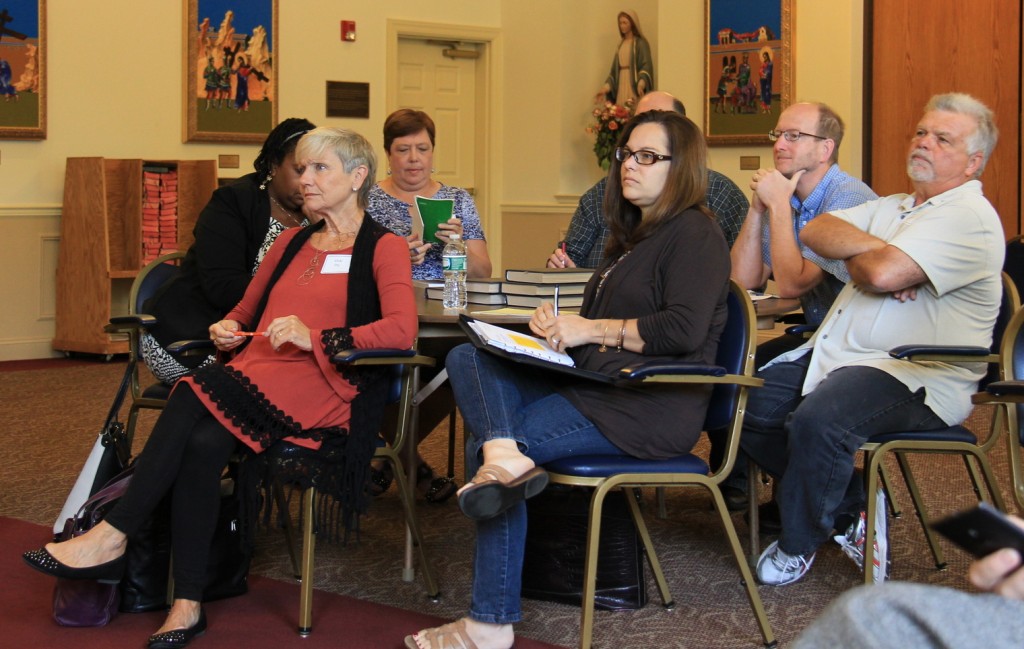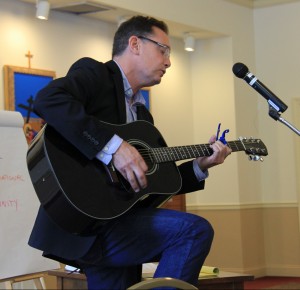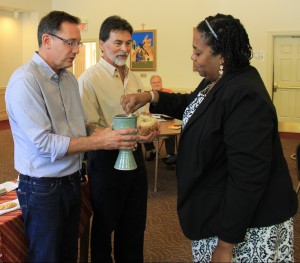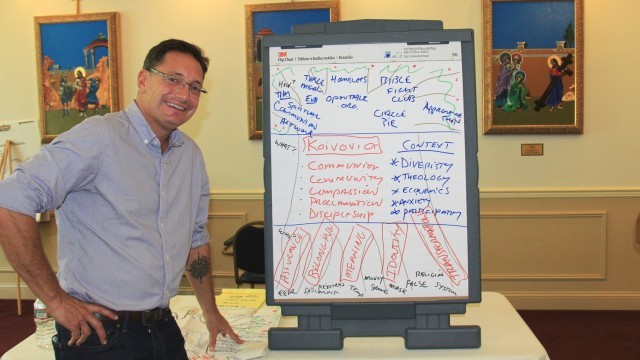Clergy members of the Southeast District gathered at the Malvern Retreat House Monday, Sept. 21, for a day apart to be renewed and inspired by the Rev. Jim Walker, an innovative pastor, speaker and author of the book Dirty Word: the Vulgar, Offensive Language of the Kingdom of God.
The book describes the Hot Metal Bridge Faith Community, which Walker and others planted in a South Side neighborhood of Pittsburgh in 2004. The outreach-focused church, connected to both The United Methodist Church and the Presbyterian Church USA, is “an affirming congregation that welcomes LGBT folks into all aspects of our church life together.”
Walker’s book is a fascinating story of that dynamic, cutting-edge church venture where people are intensely engaged in transformative ministry. He left to spend a year serving a multicultural church in the Bay Area of California, but has returned to Pittsburgh with plans to launch yet another new ministry.
 The all-day event, open to clergy from other districts also, was titled “Cultivating Healthy, Transformative Christian Community.”
The all-day event, open to clergy from other districts also, was titled “Cultivating Healthy, Transformative Christian Community.”
“Jim challenged us to move away from the ‘storefront model’ of church, where people come and receive a transaction, to a ‘bridge model’ of church, where we are sent out to build transformational Christian community life by life,” recalled the Rev. Dawn Taylor-Storm, District Superintendent, who further shared the following:
“He talked about the importance of knowing individuals. While large faith gatherings have a place in our ministry, we cannot do ministry without knowing the names of those we serve and their own faith stories. Jim talked about the bridges that Hot Metal Bridge Faith Community developed–such as Bible Fight Club, a ministry in a tattoo shop where people could discuss faith without fear. He emphasized that we need to find out what bridges we can build in our own contexts.
Some of Jim’s statements challenged us all; but he helped us think about what it means to go out of our doors and into the communities we are serving. As a DS on the Southeast District, I do see our churches building bridges in our communities– from after school tutoring programs to suicide support groups to coffee shop Bible studies. My hope is that we will continue to build bridges with those we are serving.”
Another attendee, the Rev. Julia Singleton, filed this story on the event for NEWSpirit:
 First we worshiped together singing hymns, sharing in prayer concerns, hearing poems and scripture and engaging in dialogue around these holy words. Then Rev. Walker wrote “Building Transformational Community” on the board, and together we broke down each word, discussing them at length, digging into them, wrestling with them and telling our own, relevant stories. We considered other words, too, like “planting,” “growing,” and “co-creating.”
First we worshiped together singing hymns, sharing in prayer concerns, hearing poems and scripture and engaging in dialogue around these holy words. Then Rev. Walker wrote “Building Transformational Community” on the board, and together we broke down each word, discussing them at length, digging into them, wrestling with them and telling our own, relevant stories. We considered other words, too, like “planting,” “growing,” and “co-creating.”
We compared the distinctions of community versus church. Are they the same? Is “church” a loaded word? One pastor shared what these two words bring up for her: “Community is a place where you live, while church is a place you stop by,” she said. We discussed what church looks like and what it maybe should look like in our time of over-scheduled lives.
Walker drew a tree-like image on the board and divided it into three parts: the roots, the trunk and the branches. He then related it all to ministry. The roots were the “who”– who God is, and who we are. This is the foundation of everything we do in ministry, he reasoned. If we haven’t done the work to figure out our identity in relationship to God, then the rest of what we do in ministry won’t work. We’ll end up with artificial fruit.
 The trunk is the “what”– communion, community, proclamation of the Word, compassion, discipleship and context. The branches are the “how.” These are the programs and ministries that come out of the work we’ve done and are doing, when we’re figuring out, building on and growing out of the “who” and the “what.”
The trunk is the “what”– communion, community, proclamation of the Word, compassion, discipleship and context. The branches are the “how.” These are the programs and ministries that come out of the work we’ve done and are doing, when we’re figuring out, building on and growing out of the “who” and the “what.”
We were given ideas of what to do in our own congregations. But more importantly, we were inspired by the opportunity to think deeply and thoroughly about why we do what we do, and where our ideas and ministries stem from. When we build Christ-centered communities, the “hows” will grow from that place and touch and transform lives.
By the Rev. Julia Singleton*
Photos by the Rev. James Mundell*
* Conference Communications Ministry Team members

